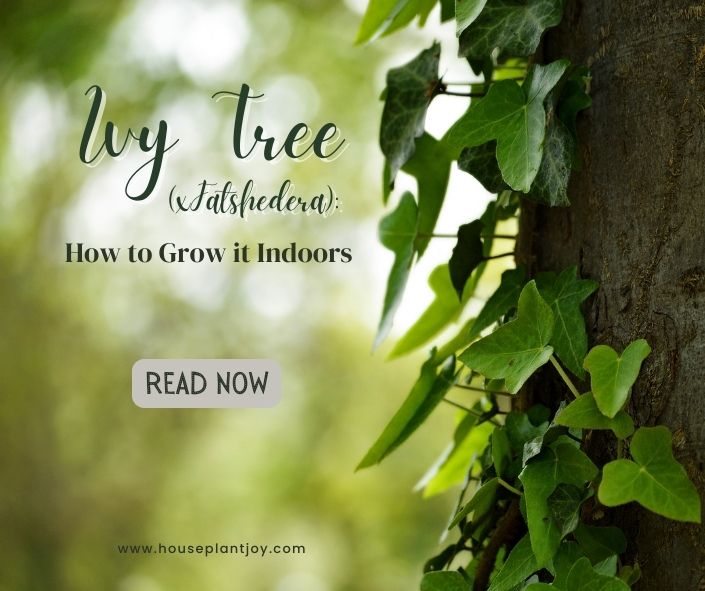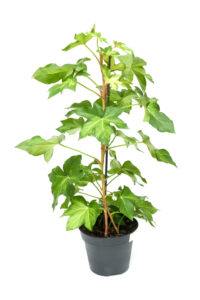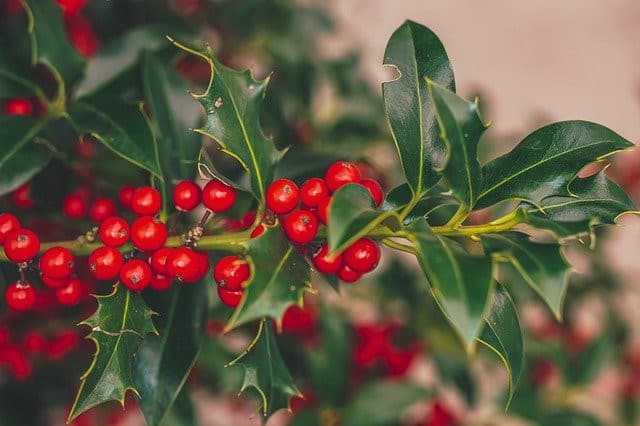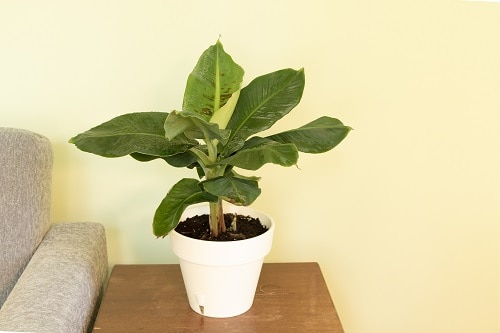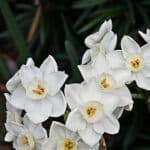HousePlantJoy is supported by our audience. When you purchase through one of our links, we may earn a small affiliate commission. As an Amazon Associate I earn from qualifying purchases. Your cost is not affected.
==================
Your Ivy Tree as a Houseplant
Hardy and beautiful, it is easy to grow an Ivy Tree Indoors. Also known as “x Fatshedera lizei, these unusual plants result from a cross between two genera, the English ivy (Hedera) and Fatsia japonica.
The resulting hybrid, with the Latin name of x Fatshedera, provides an interesting specimen. While it grows wild alongside the roads in tropical regions, growers also propagate them for houseplant specimens and houseplant specimens. The hybrid retains the leaf shape of its Fatsia japonica genetics and the climbing nature of the English Ivy. However, it cannot climb walls and trees without support.
Ivy Tree
Because Fatshedera does not grip like a true ivy, you need to provide a stake or similar support to create the tree effect. However, once correctly staked, the plant’s stems grow long, forming an attractive border to a bright window.
Ivy Tree Fatshedera Compared to English Ivy Plant
Like the English Ivy parent plant, Fatshedera prefers a cooler temperature. It also requires a high humidity level to maintain its health. Generally speaking, if you grow English Ivy successfully, you will find similar results with Fatshedera.
Discovered over a century ago, growing in the wild, Fatshedera quickly gained admirers. The oversized leaves with creamy splashes around the leaf edges resemble a giant ivy.
Ivy Tree Growing Conditions Needed
Use these guidelines for growing your ivy tree:
- Light: It thrives in anything from bright to light shade in the summer. Dimmer light suffices during winter. Dappled sunlight keeps it happy. However, it doesn’t like direct sunlight. Consider this plant for more relaxed rooms. In winter, keep at about 70°F for the best plant health.
- Water: Keep the soil moist in the summer growing season, especially for your water tree ivy. But your Ivy Tree prefers less water in the winter months when primarily dormant. Remember to use cool or room temperature water, never warm or hot. Fatshedera enjoys a mist occasionally to raise humidity.
- Fertilizer: Feed weekly with a weak liquid fertilizer during the growing season, particularly ensuring it includes micronutrients to encourage blooming. Fertilize tree ivy, like Fatshedera, responds well to ample fertilization as it is a heavy feeder.
- Soil: Use light, fast-draining potting soil, especially if tree ivy prefers it. Some like to use fortified grounds.
Propagation
As a sterile hybrid, Ivy trees, particularly those of the Pia tree variety, propagate stem-tip cuttings, not seeds. While not essential, using a rooting hormone increases the odds of success in Pia tree ivy propagation. Also, please keep the humidity level high.
Repotting
Repot each year at the beginning of the new growing season, especially for a tree ivy houseplant. When repotting, use fresh potting soil and choose a pot at least one size larger than it currently grows.
The Ivy Tree needs cooler temperatures anytime. However, excessive heat causes even more stress during repotting and shortly after. Avoid exposure to warmer temperatures, especially during repotting and shortly after.
Fatshedera often appears relatively sparse. Plant two or three in the same pot to create a bushier look. Alternatively, try pinching off the growing tips of emerging stems. This encourages some side growth.
Varieties
As a hybrid cross of English ivy and Fatsia japonica, Fatshedera exists in only one variety. Because it is sterile, as many hybrids are, Fatshedera does not cross with other species, either. However, several variations exist. They show increased leaf variegation or larger cream-color splotches on the leaves.
Grow an Ivy PlantUsing These Tips
As with English ivy, providing plenty of humidity with cooler temperatures is key to successfully growing these. Avoid over-watering as it causes leaves to turn yellow and often drop off. Likewise, hot, dry air causes the leaves to turn brown and drop off the plant.
Increase the light to increase the color variegation in plants with green and cream coloring. More light results in stronger variegation. However, leaves that are all green with no cream need less light. Growers consider them easier to grow due to the lessened light needs.
To increase growth, consider these two choices. Using a climbing post, train the plant to grow vertically. This usually requires tying the plant to your post, as Fatshedera does not climb like the English Ivy parent.
Alternatively, if you don’t have room for a climbing plant, pinch off the growing shoots to encourage a shrubby growth habit.
Pests You Might Find When You Grow an Ivy Tree
Fatshedera plants are vulnerable to spider mites, aphids, and mealybugs. As such, look under the big leaves for signs of infestation. Also, look for crinkling or curled leaves.
Always treat infestations early to prevent the pests from spreading to the whole plant or your other houseplants.
Ivy Tree Outstanding Qualities
Nicknamed “botanical wonder” due to its hybridization, Fatshedera combines the qualities of both parents: Fatsia japonica and Hedera helix (English ivy).
One parent, English Ivy, happily climbs wherever it grows. The other, Fatsia japonica, grows as a shrub. Fatshedera combines these by growing vertically like ivy but then falling over and continuing its growth across the ground. However, tying the thin, pliable branches onto a support post or pole enables us to train them to climb.
Fatshedera produces shiny, dark green leaves about 8 inches wide. In spring, look for new growth covered with a fine layer of rusty brown hairs. A flourishing plant produces small clusters of white flowers in the fall.
But don’t worry about seedlings. This hybrid, like many bigeneric, remains completely sterile. NOTE: The x sign preceding the genus names indicates it is a bigeneric hybrid. The term bigeneric means that the parent stock crossed represents a different genus.
Ivy Plant Quick Facts
Plant Type: vine
Foliage Type: evergreen
Plant Height: 24 in. (0.61 meters)
Plant Width/Spread: 10 ft. (3.05 meters)
Hardiness: USDA Zones 7 to 9
Sun/Light Exposure: sunlight, filtered light, will tolerate shade
Water Requirements: regular summer watering brings total, lush growth
Ivy Plant Colors & Combos
Great Color Contrasts: silver, gold, blue, variegated
Great Color Partners: dark green, white, chartreuse
Culture: This evergreen hybrid prefers rich, well-drained soil. It tolerates sandy soil or clay but requires good drainage. While it needs regular watering in the growing season, it requires less in the winter. Please protect it from the full sun to keep its color and growth.
Indoor Growing Requirements for Ivy Fatshedera
Watering Requirements for Ivy Plant Fatshedera
Pruning and Maintenance Requirements for Ivy Fatshedera
How to Grow Fatshedera (Indoor Ivy Tree) in Containers for Partial Shade
If you’re looking for an attractive and versatile indoor plant, the Fatshedera, commonly known as the indoor Ivy tree or bush Ivy, is an excellent choice. Its lush foliage and adaptability make it a popular container plant for indoor gardens. In this section, we will guide you on how to care for your Fatshedera indoors, ensuring its healthy growth and thriving in partial shade.
- Choosing the Right Container: When selecting a container for your Fatshedera, opt for one that provides adequate drainage. A container with drainage holes will prevent waterlogged soil, which can lead to root rot. Also, please make sure the pot is large enough to accommodate the plant’s root system and allow room for growth.
- Selecting the Ideal Location: The Fatshedera thrives in partial shade, making it an excellent choice for indoor cultivation. Find a location in your home that receives bright, indirect, or dappled sunlight throughout the day. Avoid placing the plant in direct sunlight, as it can scorch the leaves.
- Soil Requirements: Use well-draining potting soil that retains some moisture without becoming waterlogged. A mixture of peat moss, perlite, and compost can create a suitable medium for your Fatshedera. Avoid heavy clay soils that can retain too much water.
- Watering: Keep the soil evenly moist but not soggy. Water your Fatshedera when the top inch of the soil feels dry. Be cautious not to overwater, as this can lead to root rot. During winter, reduce the watering frequency to accommodate the plant’s dormant period.
- Humidity: Fatshedera thrives in environments with moderate to high humidity. To create a humid atmosphere, mist the leaves regularly or place a tray filled with water near the plant. You can also use a humidifier to maintain optimal humidity levels.
- Fertilization: Feed your indoor Ivy tree with a balanced liquid fertilizer once a month during the growing season (spring and summer). Follow the instructions on the fertilizer packaging to ensure proper application. Avoid fertilizing during the winter months when the plant is dormant.
- Pruning: Prune your Fatshedera regularly to maintain its shape and control its size. Remove any dead, damaged, or yellowing leaves to promote healthy growth. You can also trim back leggy branches to encourage bushier growth.
Following these care guidelines, you can enjoy a thriving Fatshedera (indoor Ivy tree) as a beautiful addition to your indoor garden. Its lush foliage and adaptability to partial shade make it a versatile and attractive container plant. Remember to provide the right amount of light, water, humidity, and regular pruning to ensure the plant’s health and longevity.
In Summary
FAQs on Ivy Tree Fatshedera
How is an ivy tree plant as a houseplant?
If you are still in search of a houseplant, ivy tree fatshedera is a great option for you. This plant does well indoors, thanks to its preference for humidity and moderate to bright light. You can also place it outdoors in the summertime in warm climates. But, make sure to bring it back inside before the temperature dips below 50 degrees Fahrenheit.
What are the watering requirements for ivy tree fatshedera?
You need to water your ivy tree fatshedera generously, especially when it is young. Allow the soil to dry out somewhat between waterings. You should also fertilize with a balanced fertilizer every two weeks during the growing season.
How often does ivy fatshedera need pruning?
You should prune your ivy tree fatshedera regularly to maintain its shape. Prune back the branches as needed and remove any dead or diseased leaves.
What are some common problems with ivy fatshedera?
Some common problems with ivy tree fatshedera include overwatering, under watering, and fertilizing too often. Make sure to read the care instructions carefully in order to prevent these issues. Another issue could be pests, so keep an eye out for any signs of infestation and take action if necessary.
Can variegated ivy grow indoors?
Yes. An ivy tree can grow indoors but you need to ensure you have the right temperature. This houseplant needs to be in room temperatures between 50 to 70 degrees Fahrenheit during the day. At night, it should be around 5-10 degrees or lower. The best thing about an ivy tree houseplant is its adaptability. Many conditions such as lack of light, drafty windows, or changing seasons will not bother this plant. It is one of the easiest plants to keep alive.
How do you care for variegated tree ivy?
Caring for variegated tree ivy is easy. You should water it when the soil feels dry to the touch. Keep in mind that this plant likes humidity, so you may need to water it more often if the air is dry. Make sure to fertilize it every other week with a balanced fertilizer. Prune it back as needed and remove any dead or diseased leaves. You can also move it outdoors in the summertime if you live in a warm climate. Just make sure to bring it back inside before the temperature dips below 50 degrees Fahrenheit.
Can ivy tree plants live in low light?
An ivy tree plant can live in low light but it may not grow as well. This plant prefers bright, indirect light. If you have a spot in your home that gets sunlight for only a few hours a day, you can still place your ivy tree there. You need to supplement it with artificial light. You can also rotate the pot so the plant receives light from all sides.
Why is my indoor ivy dying?
There are many reasons why your indoor ivy may be dying. The most common reasons are overwatering, under watering, and not giving it enough light. To revive your indoor ivy, start by checking the water level. Make sure to water it when the soil feels dry to the touch. You should also fertilize it every other week with a balanced fertilizer. If it is still not doing well, move it to a spot that gets more sunlight.
How tall does an ivy fatshedera grow?
An ivy tree fatshedera can grow up to 8 feet tall. Make sure you have enough space for it before you purchase one. This plant is also very versatile and you can place it in a variety of locations, such as in a pot on the porch or in the garden.
What type of soil does an ivy fatshedera need?
Ivy tree fatshedera prefers a well-draining soil mix. You can make your own mix by combining equal parts potting soil, compost, and perlite.
Is ivy plant poisonous?
No, ivy is not poisonous. However, some people may experience an allergic reaction if they come into contact with it. You can always wear gloves when pruning or handling the plant.
Is the ivy fatshedera an evergreen?
Yes, the ivy tree fatshedera is an evergreen. This means that it will keep its leaves throughout the year. It may lose some leaves during winter but it will eventually grow back.
What is the best way to propagate ivy tree fatshedera?
The best way to propagate ivy tree fatshedera is by taking cuttings from a healthy plant. Cut a stem about 6-8 inches long and remove the leaves from the bottom two-thirds of the stem. Dip the end of the stem in rooting hormone then place it in a soil mix. Keep the soil moist and wait for the new plant to grow.

